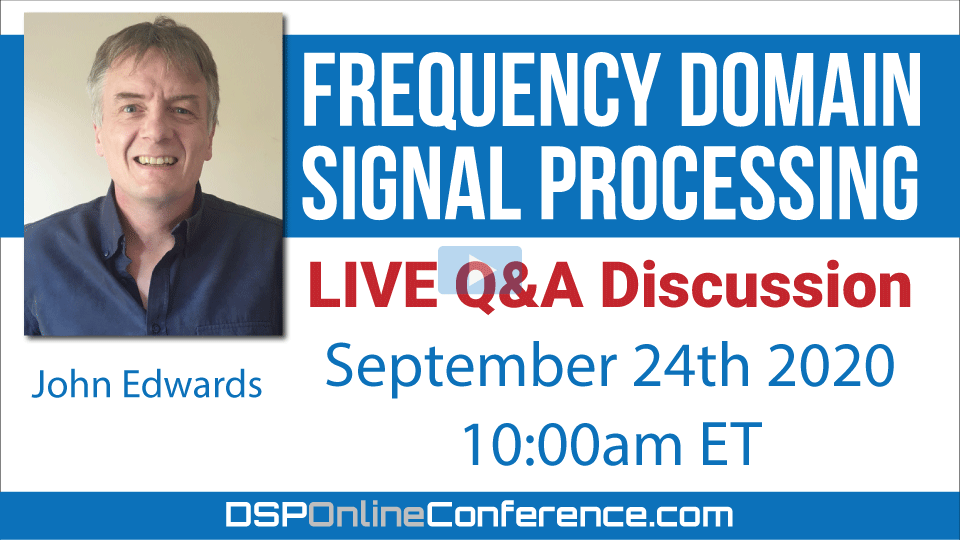Home > On-Demand Archives > Q&A Sessions >
Live Q&A Discussion - Frequency Domain Signal Processing
John Edwards - Watch Now - DSP Online Conference 2020 - Duration: 27:13

This is a the live Q&A session for the talk given by John Edwards and titled 'Frequency Domain Signal Processing'
11:00:57 From Evan : Two questions: 1. Are cascaded integrator comb filters the type typically used for on-chip sigma-delta data converters (decimator for ADC, interpolator for DAC)? 2. Overlap-add vs overlap-save, is there a difference in effective filter response, since overlap-add isn't exactly the same operation as the fully time-domain convolution operation? 11:02:19 From mnapier : Lenard I would be interested in that paper. 11:04:00 From Chris Bore : In medical radar applications, using VNA (Vector Network Analyzer) the measurements are of CW signals, in I and Q (amplitude and phase, or complex phasor) - but most commonly FFTed to time domain pulse because that is what the radar engineers are used to - tell me that makes no sense? 11:04:56 From Michael Kirkhart : Might this be the app note? 11:05:00 From Michael Kirkhart : http://xanthippi.ceid.upatras.gr/people/psarakis/courses/DSP_APL/demos/APR8-sigma-delta.pdf 11:05:49 From Jonathan Bramwell : When filtering in the frequency domain should you window the time domain data prior to fft. and does the choice of windowing function effect the filter response? 11:06:17 From Ali Ficici : I have designed CIC filters for large interpolation or decimation rates. They are efficient but the BW of the signal needs to be fairly small compared to fs because of the droop in the filter. 11:07:26 From Evan : thanks! 11:13:10 From Timothy Young : Thanks for a great talk! 11:19:42 From christophe Blouet : the FFT should provide you accurate frequency and phase, the phase gives very good information on the timing 11:20:04 From christophe Blouet : and it's possible to go beyond FFT resolution 11:20:07 From Michael Kirkhart : No problem speakers to learn to say "let's take this offline' quicker 11:28:47 From Leo : Very interesting session 11:28:50 From Leo : thank you very much 11:29:00 From Ali Ficici : thanks John! 11:29:15 From Arthur Lobo : Thank you


Here are answers to the questions that we did not have time to answer in the live session.
From Evan
Two questions:
Are cascaded integrator comb filters the type typically used for
on-chip sigma-delta data converters (decimator for ADC, interpolator for
DAC)?
Yes, they are exactly the same.
Overlap-add vs overlap-save, is there a difference in effective
filter response, since overlap-add isn't exactly the same operation as
the fully time-domain convolution operation?
Overlap-add, overlap-save and time domain convolution will all give exactly the same result.
From Chris Bore
In medical radar applications, using VNA (Vector Network Analyzer) the measurements are of CW signals, in I and Q (amplitude and phase, or complex phasor) - but most commonly FFTed to time domain pulse because that is what the radar engineers are used to - tell me that makes no sense?
In a CW application, the phase should give you the delay, if that is what you are looking for.
From Michael Kirkhart
Might this be the app note?
http://xanthippi.ceid.upatras.gr/people/psarakis/courses/DSP_APL/demos/APR8-sigma-delta.pdf
Yes, that it the one. Thank you, Michael.
From Jonathan Bramwell
When filtering in the frequency domain should you window the time domain data prior to fft. and does the choice of windowing function effect the filter response?
Excellent question. If you are using one of the overlap methods then the iFFT on the output unrolls the windowing effects from the input so you do not need to use a window.
From Ali Ficici
I have designed CIC filters for large interpolation or decimation rates. They are efficient but the BW of the signal needs to be fairly small compared to fs because of the droop in the filter.
That is absolutely correct, Ali, which is why the standard FIR filter after the CIC filters will typically have a slightly non-flat pass-band to compensate for the CIC roll-off.
From km
is the phase role implementation you mentioned for delay compensation? if so could you expand?
Yes. Phase roll is an artefact of satellite communications where the up and down links have slight errors in their frequencies that can lead to problems with echo cancellers etc.
The phase roll simulator converted time domain signals to the frequency domain, rotated the phase and then converted back to the time domain.
This was used to develop an algorithm to detect and compensate for phase roll, in the ground based modems.
From Arthur Lobo
Can you briefly discuss Generalized Cross Correlation?
Hi Arthur, sorry we didn't have time to discuss this live.
This is a big subject so I would recommend the follwing links:
https://en.wikipedia.org/wiki/Cross-correlation
https://www.dspguide.com/
The DSP Guide is a particularly good DSP reference.
If anyone has any more questions then please do not hesitate to get in touch : jedwards@numerix-dsp.com
Enjoy the rest of the conference,
John